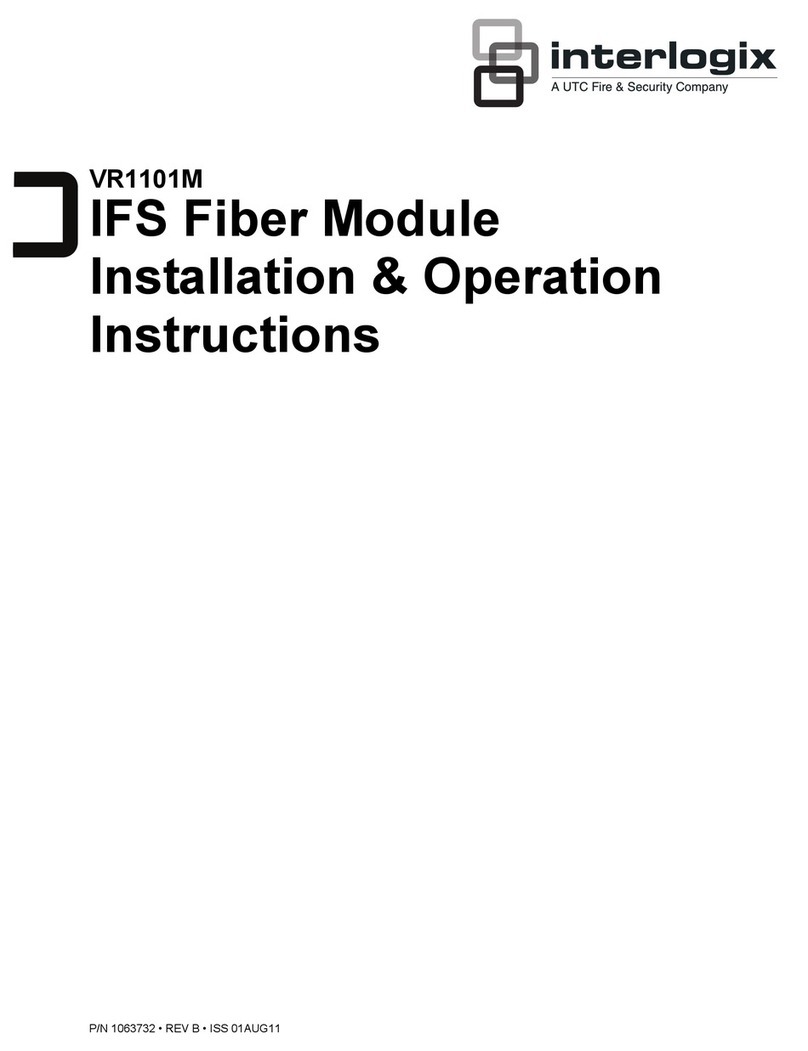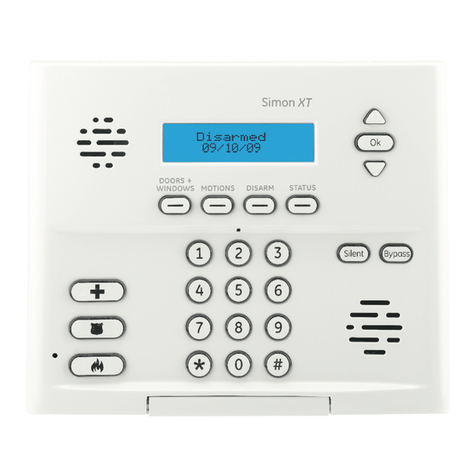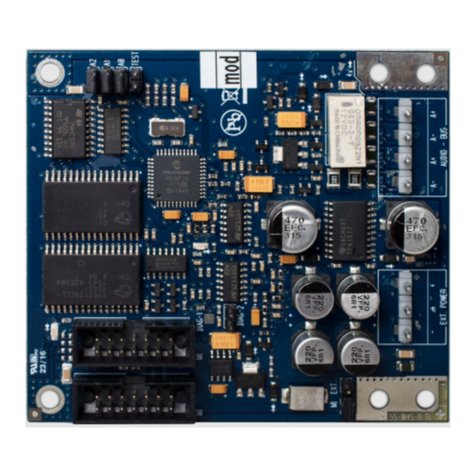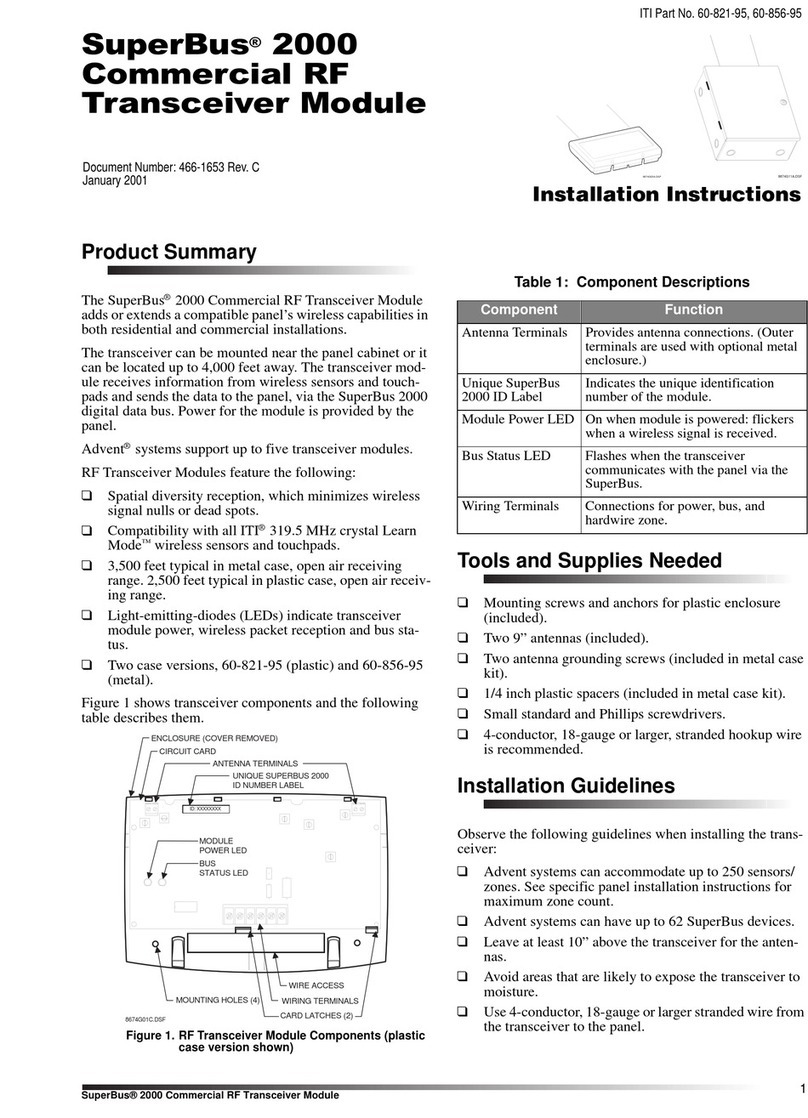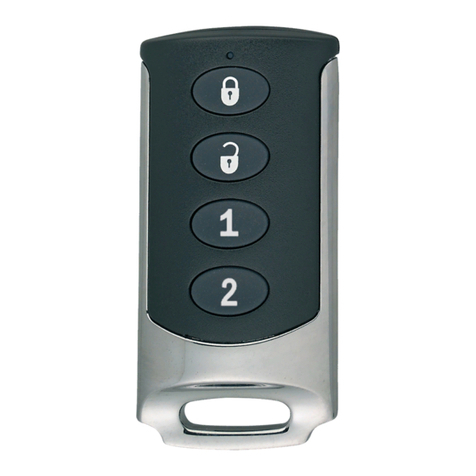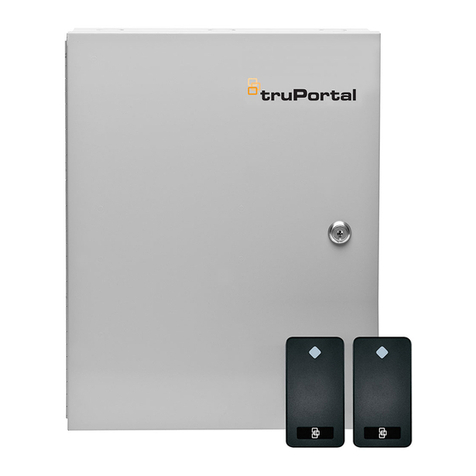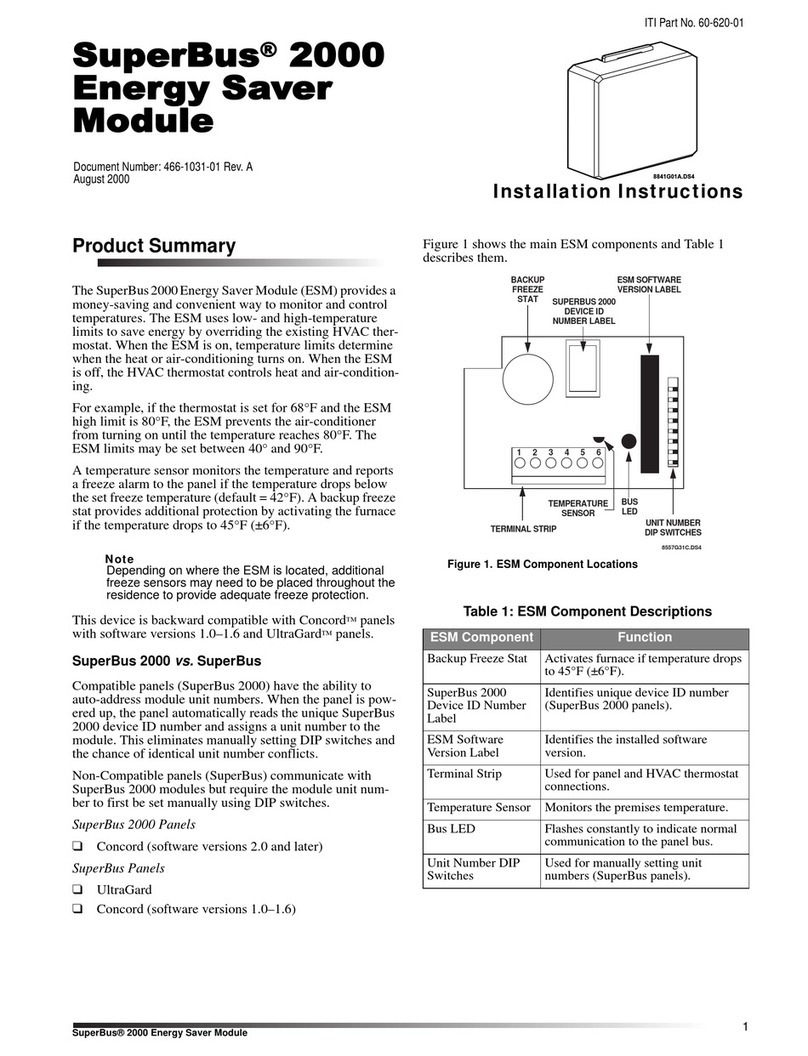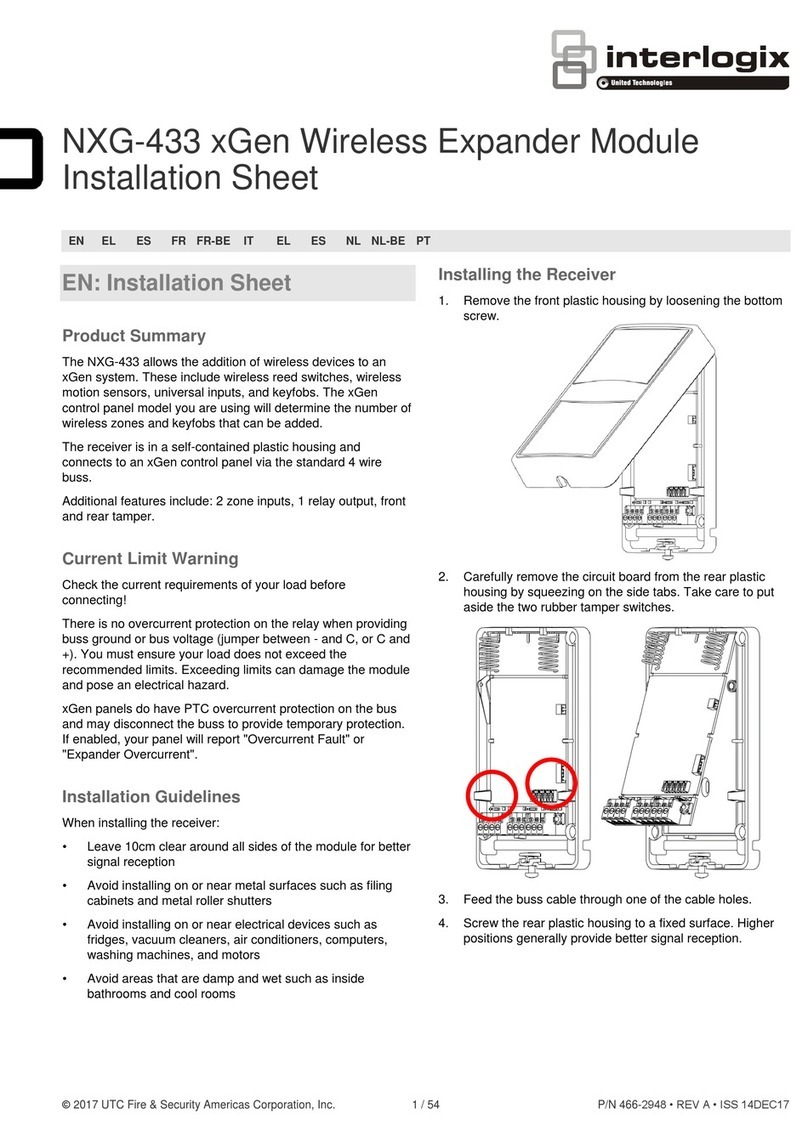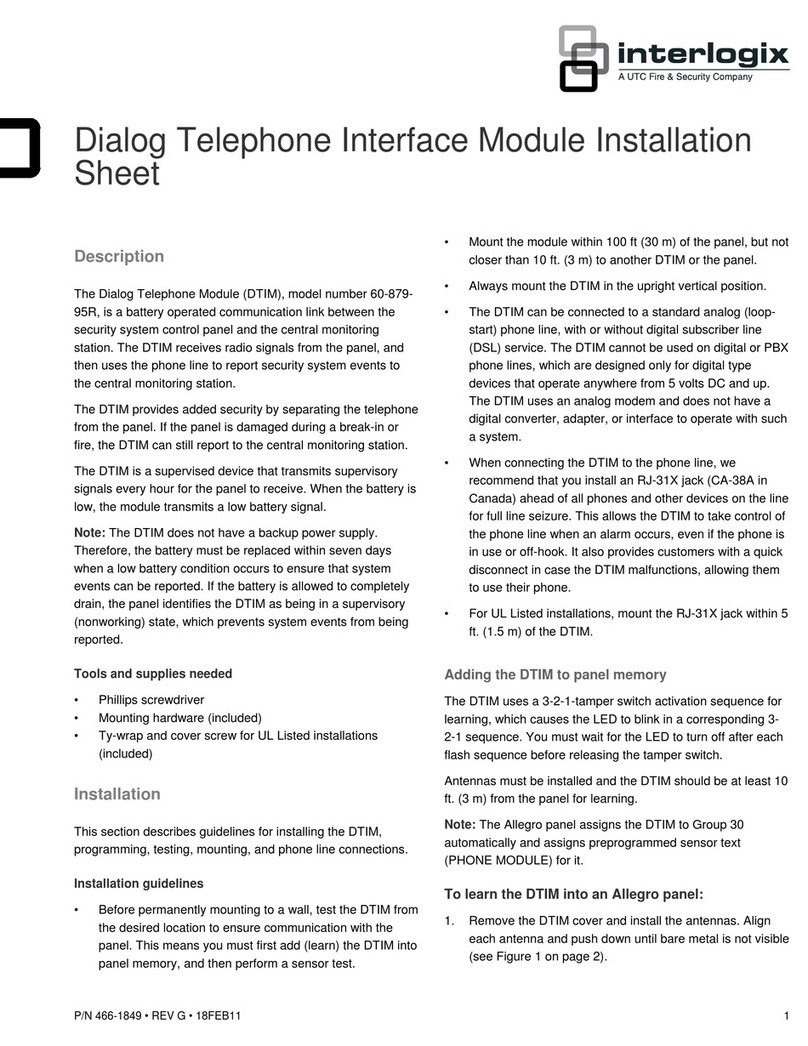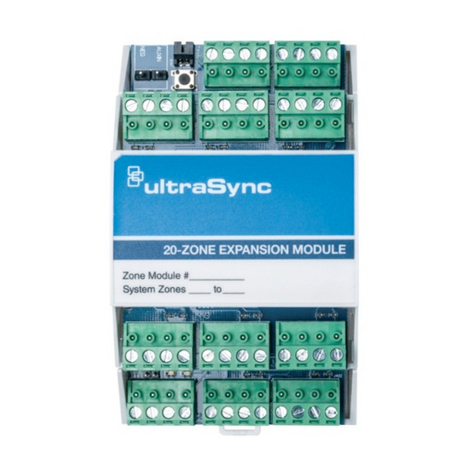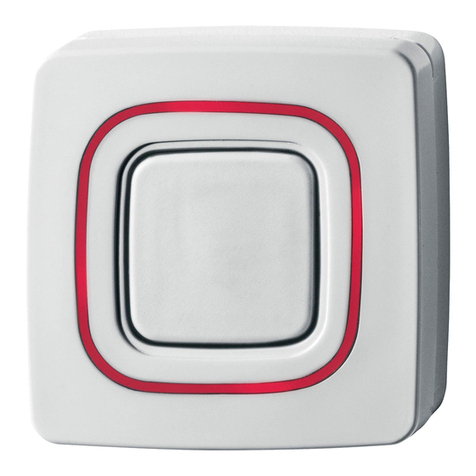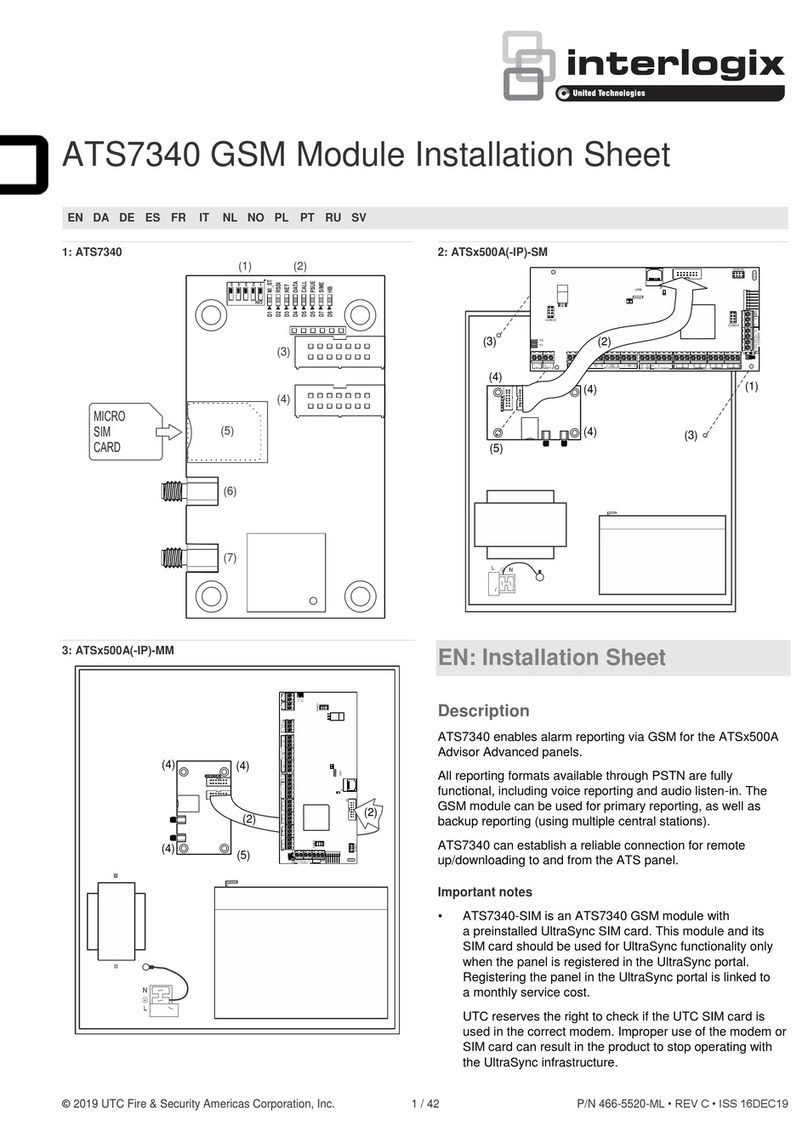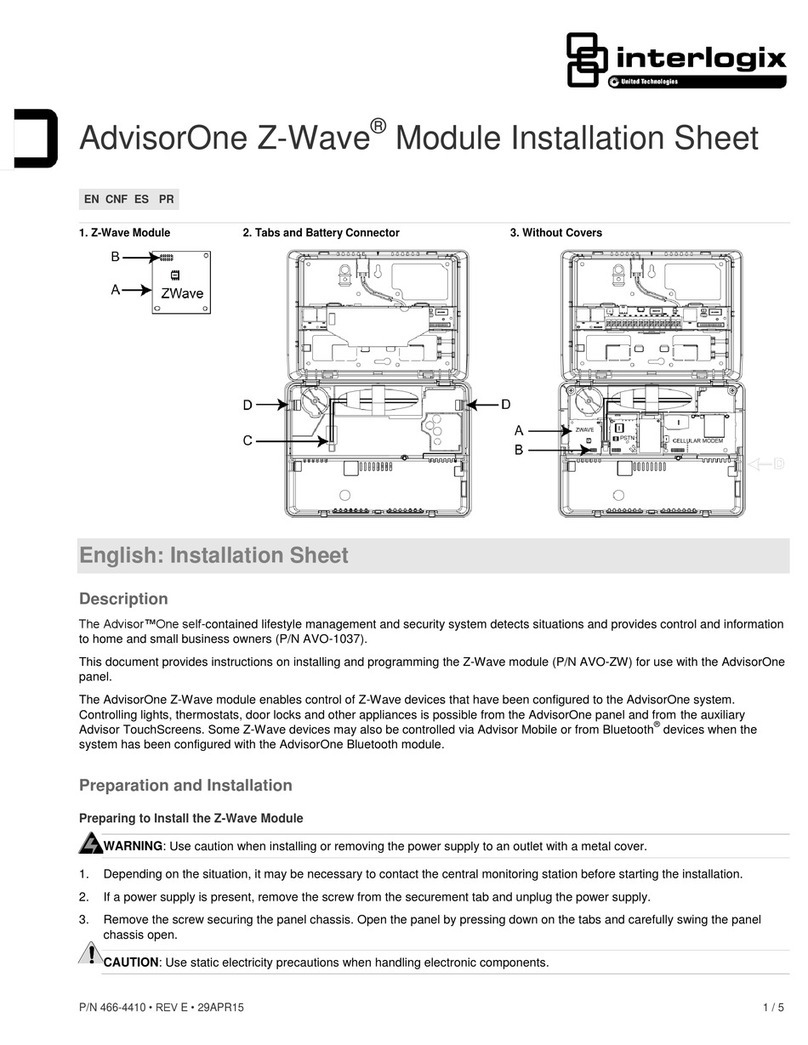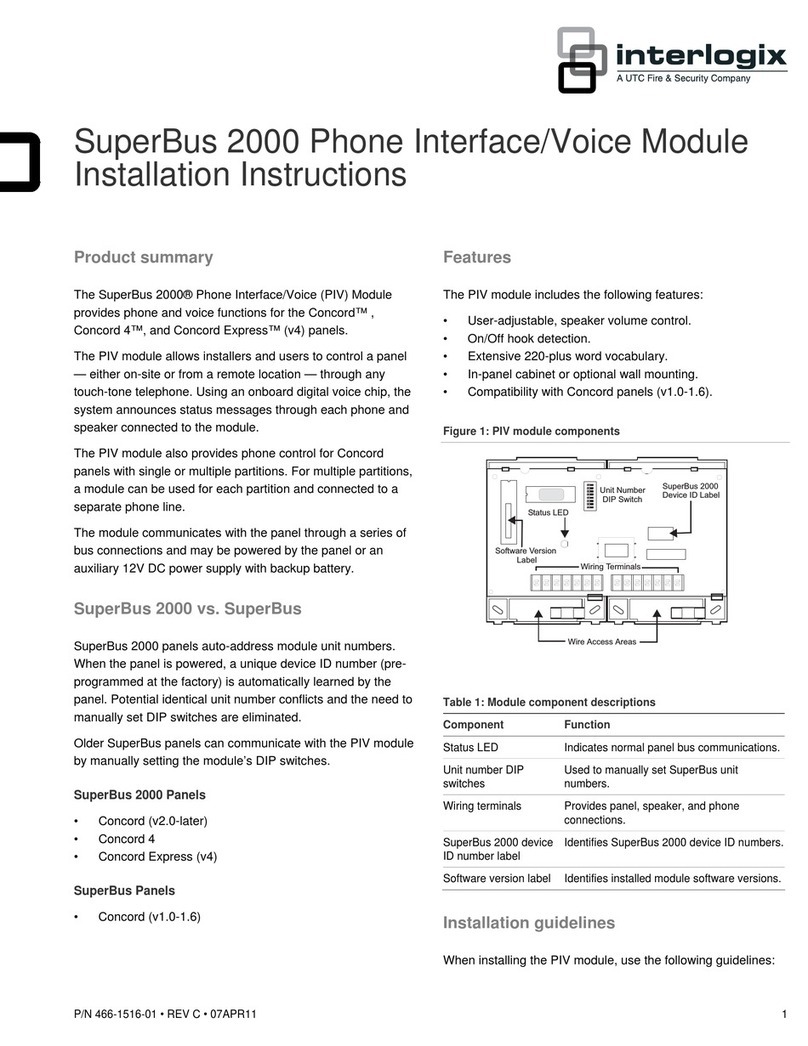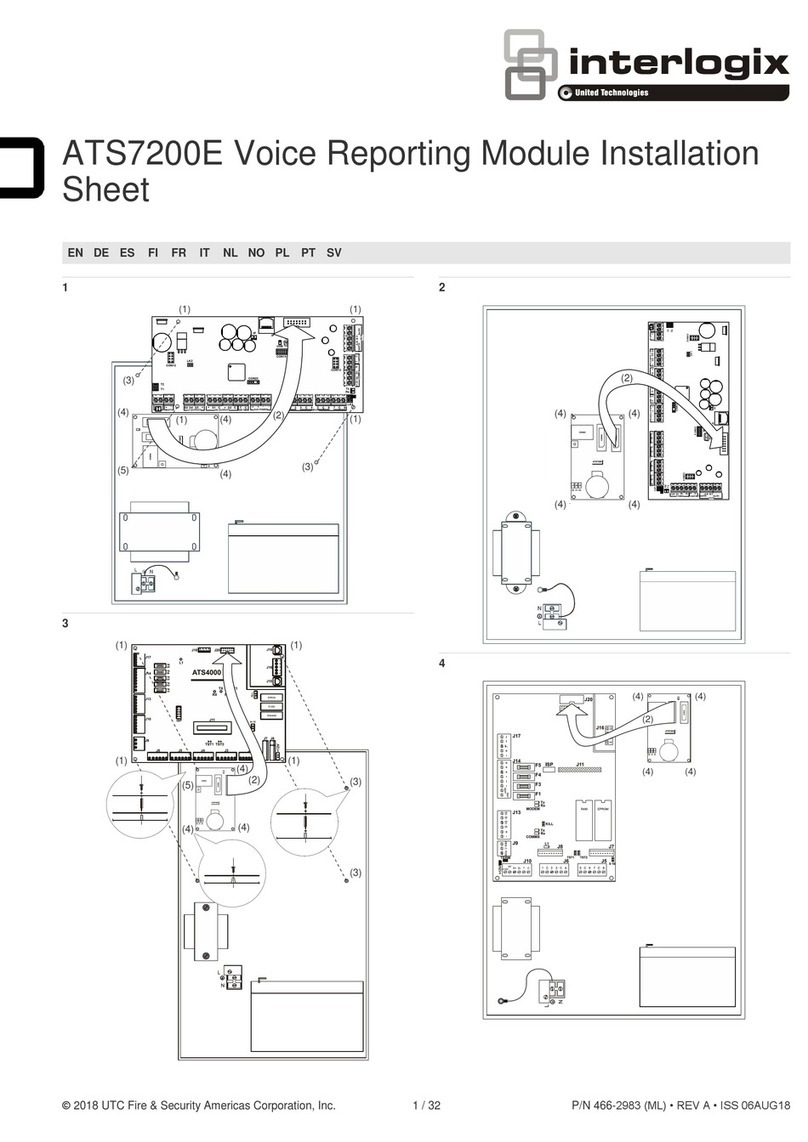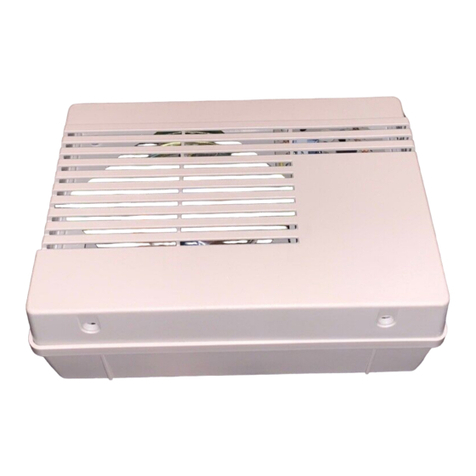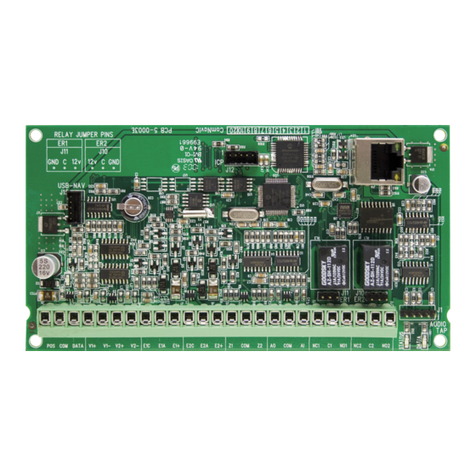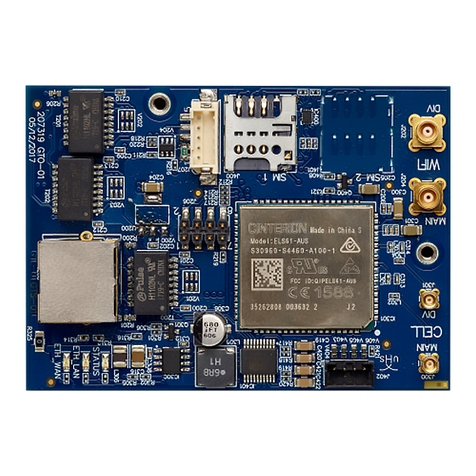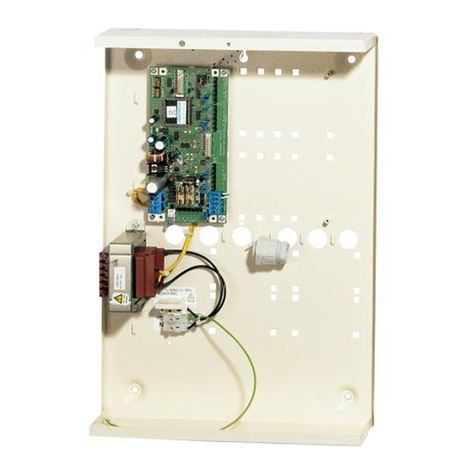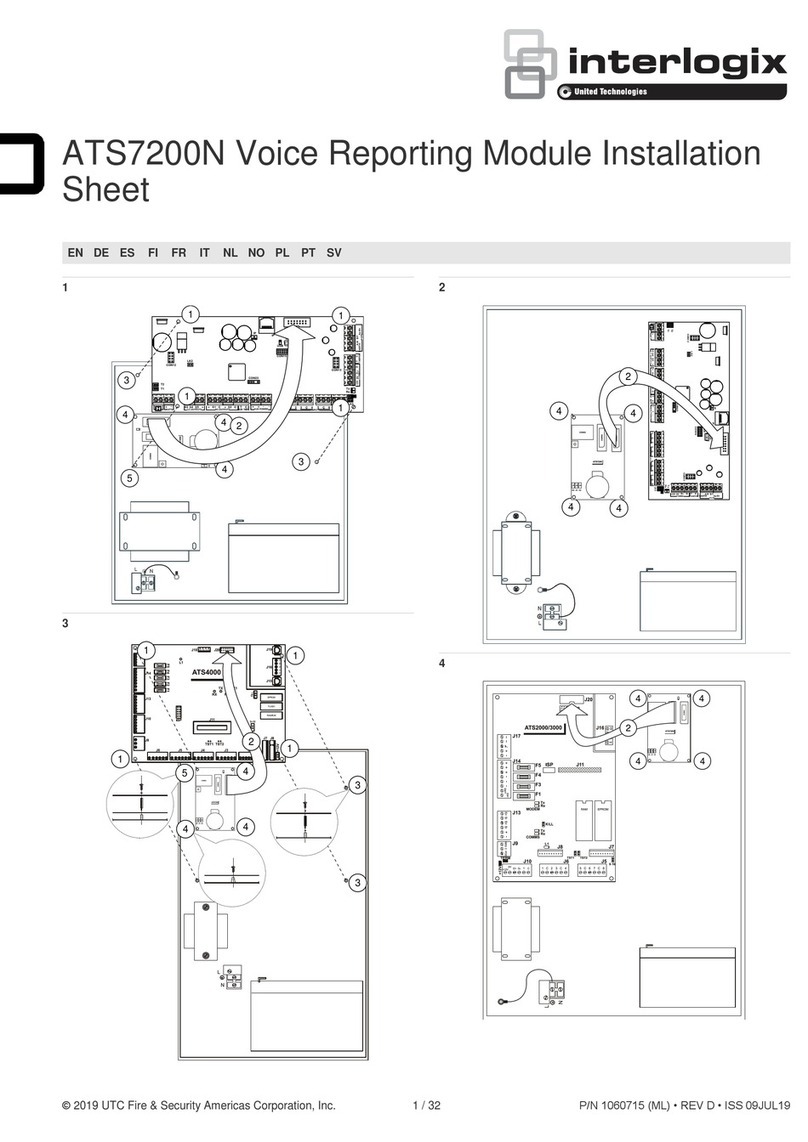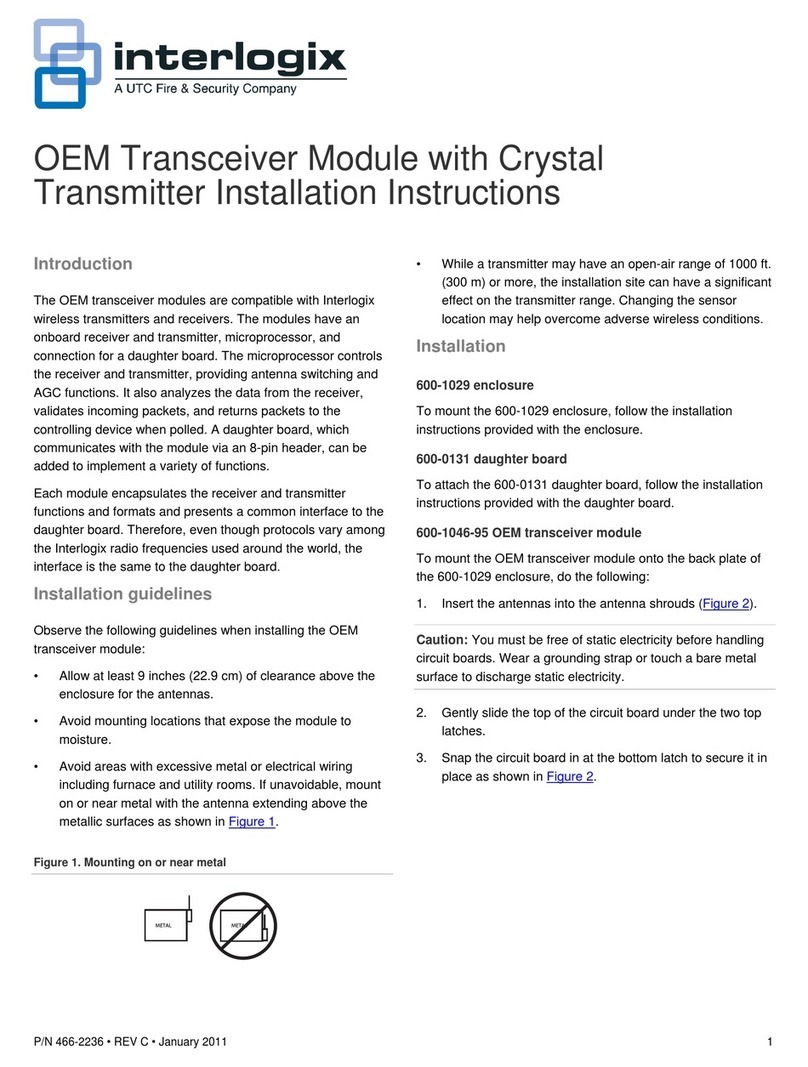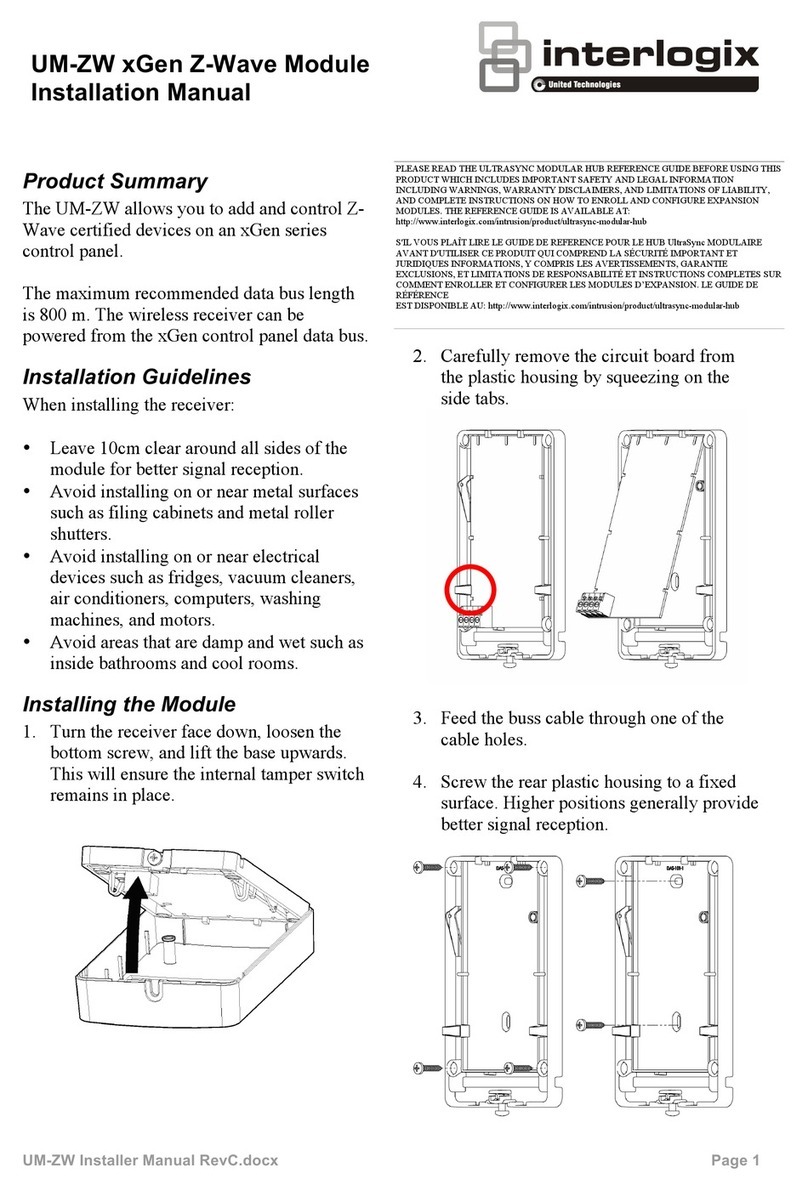
©2017 United Technologies Corporation 2 / 2 P/N 466-5276 • REV C •ISS 14FEB17
Blinks when sending data to control panel
Blinks when receiving data from control panel
Blinks when valid packet received from sensor or keyfob
Blinks when valid packet received
A triple blink every second indicates module not enrolled, a
single blink every second indicates module is enrolled
UM-W7 Programming
Consult the UltraSync Modular Hub Reference Manual for programming the UM-W7.
Note on Tamper
Two rubber push buttons provide front case and rear wall tamper.
To clear an Expander Tamper condition, both tamper inputs must be sealed. The
enclosure should be firmly mounted on a flat surface with the cover closed.
If either tamper input is open then an Expander Tamper condition will occur.
Note on Relay Modes
The receiver features one Single Pole Double Throw (SPDT) Form C relay.
The relay is connected to output terminal J6 with Normally Open and Normally
Closed connections for your convenience.
The red LED (D14) lights up when the relay is energized.
The relay can be configured in 3 different modes to support different applications.
Use jumper on J5 to select the mode suitable for your requirements.
Default is no jumper with relay in NC position.
No Jumper
Dry contact closure provided to output terminal. Maximum Load 30VAC @ 0.5A or
30VDC @ 1A.
Jumper between - and C
Buss Ground provided to output terminal @ typical 0V.Do not exceed relay rating
which is maximum load 30VAC @ 0.5A or 30VDC @ 1A.
Jumper between C and +
BUS Voltage is provided to output terminal @ typical 12-13VDC. Maximum Load @
12V is total panel current of 1,000 mA, this includes all connected devices such as
keypads, cellular module, sirens and expansion modules. Do not exceed relay rating.
Adding and Removing Wireless Devices
Refer to the UltraSync Modular Hub Reference Manual for adding and removing
wireless devices.
Completing Installation
1. Re-install the front rubber tamper button if it was removed.
2. Re-install the front plastic housing and tighten the bottom screw
Warning:
CHECK THE CURRENT REQUIREMENTS OF YOUR LOAD BEFORE CONNECTING. THERE IS NO OVERCURRENT PROTECTION ON
THE RELAYS. YOU MUST ENSURE YOUR LOAD DOES NOT EXCEED THE RECEMMENDED LIMITS ABOVE. EXCEEDING LIMITS CAN
DAMAGE THE MODULE AND POSE AN ELECTRICAL HAZARD THAT COULD RESULT IN A FIRE OR CAUSE SERIOUS ELECTRICAL
SHOCK OR LOSS OF LIFE.
THE ULTRASYNC MODULAR HUB HAS OVERCURRENTPROTECTION ON THE BUS AND MAY DISCONNECT THE BUS TO PROVIDE
TEMPORARY PROTECTION. IF ENABLED, YOUR PANEL WILL REPORT “OVERCURRENT FAULT” OR “EXPANDER OVERCURRENT.”
REPEATED OVERCURRENT CONDITIONS CAN RESULT IN PERMANENET DAMAGE TO THE PANEL OR CONNECTED DEVICES.
Attention:
VERIFIER LES CONDITIONS ACTUELLES DE VOTRE CHARGE AVANT DE CONNECTER.
IL N'Y A PAS PROTECTION DE SURCHARGE SUR LES RELAIS. VOUS DEVEZ ASSURER VOTRE CHARGE NE DEPASSE PAS LES
LIMITES SUGGERER CI-DESSUS.
SUPERIEURE LIMITES PEUVENTENDOMMAGER LE MODULE ET POSE UN RISQUE ÉLECTRIQUE QUE POURRAIT CAUSER UN
INCENDIE OU ENTRAÎNER UNE GRAVE ÉLECTROCUTION OU DES PERTES DE VIE. LE HUB UltraSync MODULAIRE A DE LA
PROTECTION DE SURCHARGE SUR LE BUS DE COMMUNICATION POUR OFFRIR UNE PROTECTION TEMPORAIRE. SI ELLE EST
ACTIVÉE, VOTRE GROUPE PRÉSENTERA SON RAPPORT "SURINTENSITÉ" OU "EXPANDER SURVOLTAGE." CONDITIONS DE
SURINTENSITÉ RÉPÉTÉ PEUTENTRAÎNER UN ENDOMMAGEMENT PERMENANT AU PANNEAU OU A DES APPAREILS
CONNECTÉS.
Specifications
UltraSync Modular Hub systems
40 mA Average
65 mA Alarm/Maximum*
*If relay is inactive, calculation can be de-rated 25 mA per inactive relay. If
positive switching is utilized, additional current draw of connected load must be
included in power budget calculations.
Operating
temperature
range
Non UL/ULC installations
14° to 131°F
(-10° to 55°C)
UL/ULC installations
32° to 120° F
(0° to 49° C)
−30° to 120°F
(−34° to 60°C)
Non UL/ULC installations
up to 95% noncondensing
UL/ULC installations
up to 85% noncondensing
Product Dimensions
(W x H x D)
3.74” x 6.10 x 1.02”
95mm x 155mm x 26mm
Regulatory Information
Placed on the market by:
UTC Fire & Security Americas Corporation, Inc.
3211 Progress Drive, Lincolnton, NC, 28092, USA
This equipment has been tested and found to comply with the limits for a Class B
digital device, pursuant to part 15 of the FCC Rules. These limits are designed to
provide reasonable protection against harmful interference when the equipment is
operated in a commercial environment. This equipment generates, uses, and can
radiate radio frequency energy and, if not installed andused in accordance with
the instruction manual, may cause harmful interference to radio communications.
If this equipment does cause harmful interference to radio or television reception,
which can be determined by turning the equipment off and on, the user is
encouraged to try to correct the interference by one or more of the following
measures:
• Reorient or relocate the receiving antenna.
• Increase the separation between the equipment and receiver.
• Connect the equipment into an outlet on a circuit different from that to
which the receiver is connected.
• Consult the dealer or an experienced radio/TV technician for help.
This class B digital apparatus complies with Canadian ICES-3B.
Cet appareil numérique de la classe B est conforme à la norme NMB-003 du
Canada.
Contact Information
For contact information,visit us online at www.interlogix.com.
For technical support, see www.interlogix.com/support.
Copyright
Copyright © 2017 United Technologies Corporation. All rights reserved.
Trademarks
Interlogix is a registered trademark of United Technologies Corporation. Interlogix is part
of UTC Climate, Controls& Security, a unit of United Technologies Corporation.
